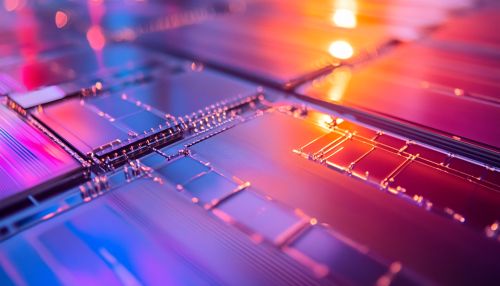Plasmonic Solar Cells
Introduction
Plasmonic solar cells represent an innovative approach in the field of photovoltaic technology, leveraging the unique properties of surface plasmons to enhance the efficiency of solar energy conversion. These cells aim to overcome the limitations of traditional solar cells by utilizing metallic nanostructures to increase light absorption and improve charge carrier dynamics.
Background
The concept of plasmonics involves the study of plasmons, which are collective oscillations of free electrons in a material, typically metals, in response to electromagnetic fields. When light interacts with metallic nanostructures, it can excite surface plasmons, leading to enhanced electromagnetic fields at specific wavelengths. This phenomenon is particularly useful in solar cells, where maximizing light absorption is crucial.
Mechanism of Plasmonic Enhancement
Plasmonic solar cells exploit the enhanced electromagnetic fields generated by surface plasmons to increase the absorption of light within the active layer of the cell. This can be achieved through various mechanisms:
Light Trapping
Metallic nanostructures, such as nanoparticles or nanowires, can scatter and trap light within the solar cell, increasing the optical path length and enhancing absorption. This is particularly beneficial for thin-film solar cells, which have limited light absorption due to their reduced thickness.
Near-Field Enhancement
The strong local electromagnetic fields generated by surface plasmons can enhance the absorption of light in the vicinity of the metallic nanostructures. This near-field enhancement can significantly increase the generation of electron-hole pairs in the active layer of the solar cell.
Hot Electron Injection
Surface plasmons can also generate high-energy electrons, known as hot electrons, which can be injected into the conduction band of the semiconductor material. This process can contribute to additional photocurrent generation, further improving the efficiency of the solar cell.
Types of Plasmonic Solar Cells
Plasmonic solar cells can be classified based on the type of metallic nanostructures used and their integration with the photovoltaic material:
Nanoparticle-Based Plasmonic Solar Cells
These cells incorporate metallic nanoparticles, such as gold or silver, into the active layer or at the interface between different layers. The nanoparticles act as scattering centers and enhance light absorption through plasmonic effects.
Nanowire-Based Plasmonic Solar Cells
Metallic nanowires can be embedded within the active layer or used as transparent electrodes. The nanowires provide a dual function of light trapping and electrical conduction, improving both optical and electrical properties of the solar cell.
Hybrid Plasmonic Solar Cells
Hybrid plasmonic solar cells combine metallic nanostructures with other light-harvesting materials, such as quantum dots or organic photovoltaics. This approach aims to synergistically enhance light absorption and charge carrier dynamics.
Materials and Fabrication
The choice of materials and fabrication techniques plays a crucial role in the performance of plasmonic solar cells:
Metallic Nanostructures
Commonly used metals for plasmonic solar cells include gold, silver, and aluminum, due to their strong plasmonic resonances in the visible and near-infrared regions. The size, shape, and distribution of these nanostructures are critical parameters that influence the plasmonic effects.
Semiconductor Materials
Plasmonic solar cells can be integrated with various semiconductor materials, such as silicon, perovskites, and organic semiconductors. The compatibility and interaction between the metallic nanostructures and the semiconductor material are essential for optimizing performance.
Fabrication Techniques
Advanced fabrication techniques, such as electron beam lithography, nanoimprint lithography, and chemical vapor deposition, are employed to create well-defined and precisely controlled nanostructures. These techniques enable the scalable production of plasmonic solar cells with high efficiency.
Performance and Efficiency
The performance of plasmonic solar cells is evaluated based on several key parameters:
Power Conversion Efficiency (PCE)
The PCE is a measure of the overall efficiency of the solar cell in converting sunlight into electrical energy. Plasmonic enhancements can lead to significant improvements in PCE by increasing light absorption and reducing recombination losses.
External Quantum Efficiency (EQE)
The EQE represents the fraction of incident photons that are converted into charge carriers and collected as electrical current. Plasmonic effects can enhance the EQE by increasing the generation and collection of charge carriers.
Stability and Durability
The long-term stability and durability of plasmonic solar cells are critical for their practical application. The stability of the metallic nanostructures and their interaction with the semiconductor material must be carefully considered to ensure reliable performance over time.


Challenges and Future Directions
Despite the promising potential of plasmonic solar cells, several challenges need to be addressed to achieve widespread adoption:
Material Compatibility
The integration of metallic nanostructures with different semiconductor materials requires careful consideration of material compatibility and interface engineering. Ensuring efficient charge transfer and minimizing recombination losses are critical for optimizing performance.
Fabrication Scalability
The fabrication of plasmonic nanostructures with precise control over size, shape, and distribution can be challenging and costly. Developing scalable and cost-effective fabrication techniques is essential for commercial viability.
Stability and Degradation
The stability of metallic nanostructures under prolonged exposure to sunlight and environmental conditions is a concern. Oxidation, aggregation, and other degradation mechanisms can affect the performance and lifespan of plasmonic solar cells.
Optimization of Plasmonic Effects
Achieving the optimal balance between light absorption enhancement and minimizing parasitic losses is crucial. Advanced modeling and simulation techniques are needed to design and optimize plasmonic nanostructures for maximum efficiency.
Applications
Plasmonic solar cells have the potential to revolutionize various applications:
Building-Integrated Photovoltaics (BIPV)
The enhanced efficiency and aesthetic flexibility of plasmonic solar cells make them suitable for integration into building materials, such as windows and facades, for generating renewable energy in urban environments.
Portable and Wearable Electronics
The lightweight and flexible nature of plasmonic solar cells make them ideal for powering portable and wearable electronic devices, providing a sustainable energy source for consumer electronics.
Space Applications
The high efficiency and lightweight properties of plasmonic solar cells are advantageous for space applications, where maximizing power generation and minimizing weight are critical factors.
See Also
- Surface Plasmon Resonance
- Quantum Dots
- Organic Photovoltaics
- Perovskite Solar Cells
- Electron Beam Lithography
- Nanoimprint Lithography
- Chemical Vapor Deposition
